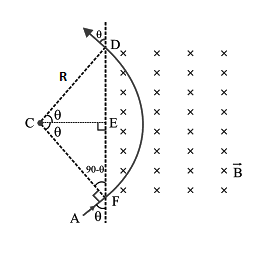
Determine the time spent by a particle in a magnetic field and change in its momentum.
Answer
217.2k+ views
Hint To find the time spent by a particle in a magnetic field we find the length of the arc (path taken by the particle in the magnetic field) by multiplying the angle made by the arc with the radius of the arc. Substituting the equation of radius in the equation of length of arc and dividing it by velocity of the particle, we get the time spent by the particle.
The change in momentum is the difference in momentum of the particle before entering the magnetic field and while leaving the magnetic field. The change in momentum is also called the impulse.
Formula used
Time spent by the particle is $t = \dfrac{l}{v}$
Change in momentum or impulse is $\Delta p = \Delta mv$
Here, Length of the arc is represented , Velocity of the particle is represented by , Time spent by the particle is given by , and Change in momentum is given by
Complete Step by step solution
The given diagram explains the path taken by the particle

Length of the arc (path taken by particle)
$ \Rightarrow l = 2\theta R$
Angle made by arc $\theta + \theta = 2\theta $
Substituting the value of radius in the length of the arc,
$ \Rightarrow R = \dfrac{{mv}}{{qB}} $
$ \Rightarrow l = \dfrac{{2\theta mv}}{{qB}} $
Here, $m,v,q,B$ represent the mass, velocity, charge of the particle, and the magnitude of the magnetic field into the plane respectively.
Dividing the length of the arc with the velocity we get the time spent by a particle in the magnetic field
$ \Rightarrow t = \dfrac{l}{v} $
$ \Rightarrow t = \dfrac{{2\theta m}}{{qB}} $
Time spent is $t = \dfrac{{2\theta m}}{{qB}}$

Momentum while entering the magnetic field is ${p_e} = mvcos\theta j + mv\sin \theta i$
Momentum while leaving the magnetic field is ${p_l} = mvcos\theta j - mv\sin \theta i$
The difference of these momentum gives us the change in momentum,
$ \Rightarrow {p_l} - {p_e} = \Delta p $
$ \Rightarrow \Delta p = (mvcos\theta j - mv\sin \theta i) - (mvcos\theta j + mv\sin \theta i) $
$ \Rightarrow \Delta p = - 2mv\sin \theta i $
The change in momentum is $\Delta p = - 2mv\sin \theta i$
Note Students may get confused with the angle with which the particle enters the magnetic field. Students may presume it as$90^\circ $. We should take the angle as $\theta $ and proceed. Time spent can also be found by dividing the angle made by an arc with angular velocity.
The change in momentum is the difference in momentum of the particle before entering the magnetic field and while leaving the magnetic field. The change in momentum is also called the impulse.
Formula used
Time spent by the particle is $t = \dfrac{l}{v}$
Change in momentum or impulse is $\Delta p = \Delta mv$
Here, Length of the arc is represented , Velocity of the particle is represented by , Time spent by the particle is given by , and Change in momentum is given by
Complete Step by step solution
The given diagram explains the path taken by the particle

Length of the arc (path taken by particle)
$ \Rightarrow l = 2\theta R$
Angle made by arc $\theta + \theta = 2\theta $
Substituting the value of radius in the length of the arc,
$ \Rightarrow R = \dfrac{{mv}}{{qB}} $
$ \Rightarrow l = \dfrac{{2\theta mv}}{{qB}} $
Here, $m,v,q,B$ represent the mass, velocity, charge of the particle, and the magnitude of the magnetic field into the plane respectively.
Dividing the length of the arc with the velocity we get the time spent by a particle in the magnetic field
$ \Rightarrow t = \dfrac{l}{v} $
$ \Rightarrow t = \dfrac{{2\theta m}}{{qB}} $
Time spent is $t = \dfrac{{2\theta m}}{{qB}}$

Momentum while entering the magnetic field is ${p_e} = mvcos\theta j + mv\sin \theta i$
Momentum while leaving the magnetic field is ${p_l} = mvcos\theta j - mv\sin \theta i$
The difference of these momentum gives us the change in momentum,
$ \Rightarrow {p_l} - {p_e} = \Delta p $
$ \Rightarrow \Delta p = (mvcos\theta j - mv\sin \theta i) - (mvcos\theta j + mv\sin \theta i) $
$ \Rightarrow \Delta p = - 2mv\sin \theta i $
The change in momentum is $\Delta p = - 2mv\sin \theta i$
Note Students may get confused with the angle with which the particle enters the magnetic field. Students may presume it as$90^\circ $. We should take the angle as $\theta $ and proceed. Time spent can also be found by dividing the angle made by an arc with angular velocity.
Recently Updated Pages
Addition of Three Vectors: Methods & Examples

Addition of Vectors: Simple Guide for Students

Algebra Made Easy: Step-by-Step Guide for Students

Relations and Functions: Complete Guide for Students

Analytical Method of Vector Addition Explained Simply

Arithmetic, Geometric & Harmonic Progressions Explained

Trending doubts
JEE Main 2026: Application Form Open, Exam Dates, Syllabus, Eligibility & Question Papers

Derivation of Equation of Trajectory Explained for Students

Hybridisation in Chemistry – Concept, Types & Applications

Understanding the Angle of Deviation in a Prism

Understanding Collisions: Types and Examples for Students

How to Convert a Galvanometer into an Ammeter or Voltmeter

Other Pages
JEE Advanced Marks vs Ranks 2025: Understanding Category-wise Qualifying Marks and Previous Year Cut-offs

Understanding Atomic Structure for Beginners

Ideal and Non-Ideal Solutions Explained for Class 12 Chemistry

Degree of Dissociation: Meaning, Formula, Calculation & Uses

Understanding Electromagnetic Waves and Their Importance

Understanding the Electric Field of a Uniformly Charged Ring




